“I don’t know where to begin.” -Paul McGann as the Doctor
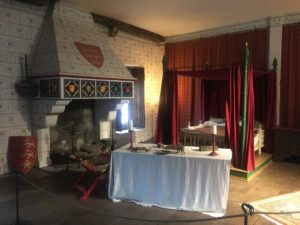
On account of the fact that the following day involved an early, early train for a day to trip to Paris (the train departing at 5:40am from St. Pancras International), we needed to take things slowly and had to plan for an early return trip back to our flat in South Kensington to try to get to sleep a little earlier than normal. Somehow, however, we still managed to see quite a bit, as it was on this day that we got to see another one of those Big Unmissables and Must-Sees, as I like to call them: the Tower of London. I cautioned my fellow travelers that I could spend hours and hours at the Tower, but they didn’t at first believe me how that could be at all entirely possible. I had warned them that I had already visited the Tower twice before, but I still had yet to see every single corner of the place. (For the uninitiated, the Tower of London isn’t just a single tower. It’s a collection of towers and other buildings on a 12-acre site, all enclosed within two imposing concentric walls.) I was determined to finally, at last, check off all the things there are to see on a third visit.
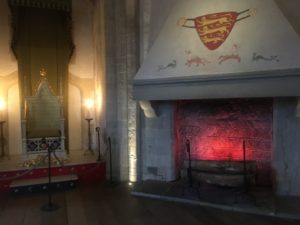
The Tower of London is located right on the north bank of the River Thames right by Tower Bridge. In its long, long history dating all the way back to 1066 (that all important year when the Normans invaded England and ended 600 years of Saxon rule), the Tower has been a prison, royal palace, and fortress. (In many ways, it’s still a fortress, as the Tower still houses and protects the Crown Jewels. More on that later.) Its status as royal palace is immediately clear if you start your visit by exploring Wakefield Tower, St. Thomas’s Tower, and Lanthorn Tower–three towers that are collectively known as the Medieval Palace. (I’d recommend starting with these three towers, as they are all located along the southern wall right as you enter, and you can plan your explorations by following the outer walls in an anti-clockwise direction.) The inside of St. Thomas’s Tower has been carefully reconstructed to look like what it might have looked like in the 13th century when this tower would have been used by Edward I as his bedchamber: an elegant bed adorned with maroon bed curtains; a stately fireplace brightened with colorful coats of arms; and in the corner a small chamber with a tiled floor of maroons and greens with a modest altar that Edward would have used for prayer. Wakefield Tower, on the other hand, is slightly more sparsely furnished, but in this open space you can gaze upon a recreation of Henry III’s throne; marvel at the stately vaulted ceiling; and pause at the private chapel (a small space sectioned off by a modest wooden screen painted in patterns of gold, green, and red) where Henry VI was murdered (his opponents contrarily insist he actually died of melancholy upon news of the death of his son). Lastly, Lanthorn Tower (which would have been the royal chambers for Eleanor, Queen Consort of England during the reign of Henry III) today houses a small exhibit containing artifacts (coins, trinkets, chalices) that help reveal what courtly life would have been like in the 13th century.
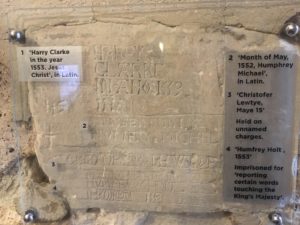
We carried onwards along the eastern wall, visiting the Salt Tower (so-named probably because this is where salt was stored, salt requiring incredible security as it was once very expensive; I can’t even image how bland soup for peasants might have once tasted) where you can view graffiti carved into the walls by countless individuals who were imprisoned in this particular tower. Our walk along the eastern wall continued north with a visit to the Broad Arrow Tower (where you can take part in an interactive exhibit, learn about how medieval garrisons would have protected the Tower, and wield a crossbow) and then a visit to Martin Tower (which used to house the Crown Jewels but now houses the Crowns and Diamonds exhibit, which details the history of the royal crowns and the various jewels that were used to adorn them). It’s near the Martin Tower where you can also view metallic wire sculptures of baboons scaling a wall. The baboons are one part of a collection of artworks by Kendra Haste who was commissioned to create a total of 13 sculptures (also including lions, a polar bear, and an elephant) that recreate the menagerie of animals that would have once lived at the Tower.
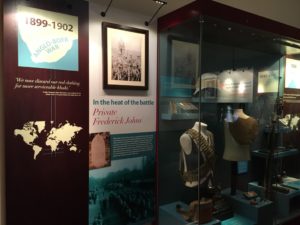
Following an actually somewhat surprisingly pleasant lunch at the New Armouries Cafe located within the Tower (one of four places to grab a bite to eat on your visit), we visited the Fusilier Museum, something I had missed on my first two previous visits to the Tower. If there’s anything that I’d recommend you skip if you are short on time, it’s this museum. Unless you have an interest in military history, you won’t find this part very engaging, but the exhibit itself is very expertly prepared. In addition to a display of a collection of various military medals awarded to distinguished individuals, there’s an informative exhibit detailing the history of the Royal Regiment of Fusiliers, created by James II in 1685 to protect the guns at the Tower, but who went on to fight in many important wars from the American War of Independence to the Second World War. On display are uniforms, photos, documents, and various other artifacts that tell the story of the fusiliers extensive involvement in Britain’s military history.
Following the museum, we made our way to the White Tower, which is the main tower that was built during the 1080s. While technically a rectangle (its base measures at 32×36 meters and stands 27 meters high), it’s an impressive square-shaped structure of stones in shades of whites, greys, and light browns with square towers on three of its corners and a round one on its fourth. Inside is the Line of Kings (a collection of suits of armor worn by long-dead monarchs, including Henry VIII, Charles I, and James II), an exhibit called Torture at the Tower (where you can view, among other things, an executioner’s block used at the last public execution in 1747), and the modest St. John’s Chapel (which we had totally bypassed by accident on account of rushing through the White Tower due to lack of time, but which I had already visited twice before and which I highly recommend you make sure to also visit).
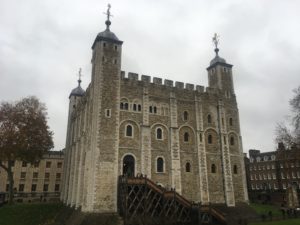
Following the White Tower, we enjoyed a real highlight from our visit to the Tower, something I highly recommend you take part in: a Yeoman Warder tour. These tours begin by the main visitors’ entrance at the southwest corner every half hour, and they last about 30 minutes. The Yeoman Warders (also called Beefeaters, possibly because they used to be paid in chunks of beef) will be sure to entertain, as they inhabit gruff characters who demand your rapt attention and brisk walking pace. The tour will always be sightly different depending on how the weather cooperates. Ours took us from the entrance to the Tower Green to the Chapel Royal of St. Peter ad Vincula, taking note of the Jewel House in the Waterloo Block on our way. In the Chapel Royal, we learned about the beheading of Anne Boleyn at the nearby Tower Green and her resting place in the Chapel Royal. The Chapel Royal was also one of the buildings I finally got to visit after having missed it twice before, so it was so lovely to finally have completed this particular pilgrimage.
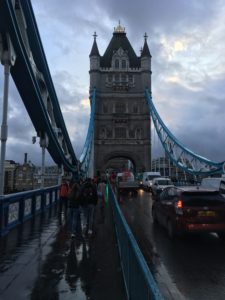
There’s really just so much to see at the Tower, which is why it’s so easy to spend hours and hours here and write paragraphs and paragraphs about it. We tried to see as much as we could, and I’m shortchanging so many of the details: the Crown Jewels (including coronation regalia, crowns and crowns and crowns, swords, maces, banqueting plates, sceptres, that one spoon); the Bloody Tower (where Sir Walter Raleigh, among others, was imprisoned first for secretly marrying his lover Elizabeth Throckmorton and later for a false accusation regarding his involvement in dethroning James I); the Beauchamp Tower (where you can see even more elaborate graffiti carved into its walls by various prisoners); and a few more locations that we didn’t have time for (the Tower’s Mint, for example). Ideally, if you have the time and if you have a deep fascination for English history, plan on spending a whole day here from open until close. It really is possible to get lost in all the Tower’s expansiveness. Fortunately, however, after three visits across thirteen years, I finally managed to see every single nook and cranny of this place!
Following the Tower of London, we needed to make our way to the Globe Theatre. So, we made our way on foot via Tower Bridge. (Do go out of your way to at least walk across the bridge, but I also must highly recommend you purchase tickets to visit the inside as well. We didn’t have time to do that this time around, but I had explored Tower Bridge more thoroughly on my last visit to London, and it was all very well worth it.) After the bridge our stroll continued west along the south bank of the Thames (which also provided us views of the docked H.M.S. Belfast, currently an Imperial War Museum that I should like to visit on a future return adventure to London). Soon, we were back at the Globe, which we had seen only from the outside on Friday when we visited the nearby Sam Wanamaker Playhouse to attend an absolutely exquisite production of Richard III, but this time around we had tickets for a guided tour of the inside of the Globe Theatre itself. We were guided by a young gentleman called Sam Veck (himself and actor), who was quite knowledgeable about Shakespeare and the history of theatre in London, telling us with just enough humor about the Globe of old (how it was conveniently located just right outside the City of London where Puritans didn’t have any power in shutting it down) and the Globe of now (how American actor Sam Wanamaker was so dismayed to discover that no physical structure existed at the site where the Globe once stood and so made it his mission to change that, and by 1997 the Globe as it stands today opened to audiences with a production of Henry V).
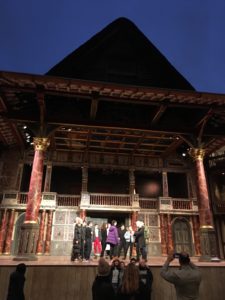
I do recommend a guided tour of the Globe, as it allows you to really take in the whole structure: the elaborately painted ceiling above the stage that depicts the moon and the Zodiac; the open air design of the 20-sided circular building with its thatched roof and three tiers of seating; the small attic space above the theatre where lots of the sound effects would be performed. The tour also allows you to hear little gems like how the two great pillars that hold up the canopy above the stage (painted in a way to suggest they are made of red marble) are made of oak trees–one from England and one from Scotland–to represent the two monarchs who lived during Shakepeare’s time, Elizabeth I and James I. Sadly, we didn’t get to watch a play at the Globe, as they don’t perform from November to March on account of how cold it would be, so we shall just have to again return to London sometime during their season!
Following the Globe, we concluded our day by having dinner at a restaurant called Goat, located near our flat in South Kensington and billed as a “New York-Italian” restaurant. I enjoyed their smoked aubergine and tomato risotto, and–having had risotto in New York at an Italian restaurant a couple years ago–I must say it really did impress. If you happen to find yourself in South Kensington, do seek out this place, as it was really quite fine dining. (Our server was quite friendly as well!) And with that, it was off to bed, much earlier than normal, as Paris awaited early the next morning…
